Rich Hoffman's Blog, page 311
March 5, 2017
Whispers from the Catacombs of Canterbury: The great work of the Time Team and B.C. trade between America and England
[image error]One of the wonderful discoveries I made while in the United Kingdom recently was the great archaeology that had been done over a fifteen year period by the Time Team. They had managed to host television shows featuring very aggressive digs over three-day periods at various sites around England, and elsewhere and putting them on television in an entertaining way. Working fast as they did, the Time Team has managed to do an enormous amount of research that has culminated in tremendous work in England in understanding their pre-history cultures, the Vikings, Anglo Saxons, Romans, Normand’s, and the relatively recent Victorian Age settlements to better assemble a history of England that nobody really understood prior. Personally the most explosive example of the Time Team’s value to the United Kingdom was the work they did in Canterbury as seen below.
My son-in-law is from that region so it had been a goal of ours to visit his homeland and get to know the elements of that place which helped shape him into the fine young man that he is now. When I first met him I was happy to learn that he was from Canterbury because Canterbury Tales was one of my favorite classic pieces of literature. Along with James Joyce’s Finnegan’s Wake, Canterbury Tales was one of those really hard books I pushed myself to read while living on campus at the University of Cincinnati in what I would call my days of breaking free of society’s intellectual shackles. Nobody was doing things like that when I was 25 freely reading those great works of literature while eating my breakfast, lunch and dinner almost every day in the Perkins at Coryville just to the east of the main campus of the University of Cincinnati. Now people did read them because their literature professors gave them homework assignments to do so, but nobody did it for fun, like I did. Even though I had a car in those days, most of my time was spent walking between the apartment I was staying at and that Perkins reading my books, such as Canterbury Tales. So it was quite odd for me that my daughter had out of all places in the world meet a young man from Canterbury and was intent to marry him.
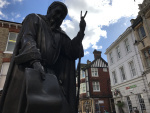


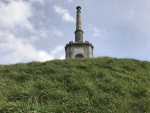

Fast forward 25 years into the future from the time that I was readying Canterbury Tales at that Perkin’s restaurant in a college campus environment to doing nearly the same thing in Canterbury itself this time not just reading classic literature in a studious setting, but seeing the places where Thomas Beckett was actually slaughtered and visiting the pubs and inns that were put on the map because of the pilgrimages to Canterbury Cathedral to visit the tomb of the slain archbishop who had fallen out of political favor with Henry II. Because the intent of the visit to Canterbury was to visit my son-in-law’s family and see how he grew up, we were staying in a flat in the 4th most expensive city in all of England just one street over from the Canterbury West train station. It was the closest thing I had come in over two decades to living the “college kid” lifestyle that I had when I first read Canterbury Tales—and it was strange. We actually lived in Canterbury as opposed to staying at a hotel. At our flat we lived like we would at home doing laundry, preparing meals, and conducting life in general outside the mode of being on vacation. There is quite a difference. Over the course of February my wife and I discovered our favorite shopping spots for getting food and we developed a nice relationship with the pizza place directly across from the Westgate Towers—because we ate a lot of pizza. Canterbury became a second home for us.

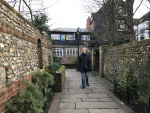


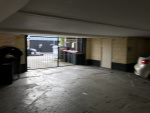
However, for the part of me who would have loved to have been an archaeologist if I could put my other interests and career paths in some other order—Canterbury was like living in a dig site. With their long history of prehistoric people who were conquered by the Romans, the Anglo Saxons, then the Normans—before being dominated by Catholicism, the history of this particular city was extraordinary and something that I soaked up like a sponge. Not to mention that it was just a short walk from our flat where the pilgrims began their journey to America—so there was plenty of history to investigate and that’s what my wife and I spent most of our time doing around Canterbury. After reading so much about the place for such a long period of time I was finally able to put my eyes on the real things and touch history as it was—which for me was very satisfying.




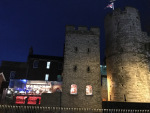
Canterbury is a microcosm of what I think has happened to the rest of the world. In the macrocosm of modern history wars have defined our understanding of things and caused a very shallow recollection of our roots toward civilization. But the world is just too big and our sciences are too slow to truly get to the roots of things. For instance, the Time Team tried to do a similar show in America on PBS but they just couldn’t get it off the ground. America is a different audience and things are spread out differently. And in regard to our mound culture in the States everything is protected by the Native American Graves Protection and Repatriation Act (NAGPRA). So archaeology has become nearly impossible in America for that very reason making it so that there isn’t any quick study over three days of the most ancient mysteries so obvious to American audiences, like Cahokia, the Newark Mound complex and Serpent Mound. But the Time Team wasn’t so constrained in the United Kingdom and what they were able to unlock in a relatively short period of time was short of extraordinary. That left a lot to explore for a guy like me in Canterbury and I relished it immensely.


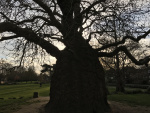

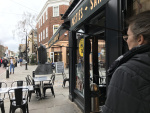


There were in Canterbury several mounds that I could see on an ancient map of the city dating back to the Romans, burial mounds all over the place just the same as were found in Stonehenge and in the United States at Fort Ancient and they all date back to the same periods. I saw physical evidence of two large ones, one at the St. Augustine’s Abby and another right next to the old Roman walls that was as tall as the Miamisburg Mound. Archaeologists in the area attributed that mound to the Romans who moved into the area, but because of my history with the mounds of Ohio, I would associate it as being before the Romans and for the same reasons. I think the Romans put their imprint on the mounds they found in Canterbury, but I don’t think they initiated them. But what was astonishing was that they were there—part of the history of Canterbury and its many microcosm layers of history were there for all to see focused on that one point in the world. There are very few places anywhere that so much history could be observed in such a preserved way in a relatively confined space. What made Canterbury unique was that it was the target for many civilizations to make their mark as opposed to building cities here and there within twenty miles of each other. At Canterbury each big revolutionary period of human consciousness along the present Vico cycle was layered on top of each other for future archaeologists such as the Time Team to reveal to the world in a glorious television production which contributed immensely to our understanding of these periods.



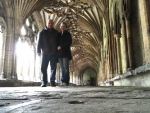
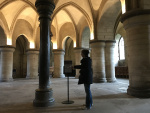
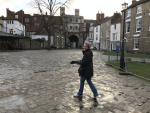

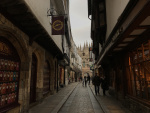
The Time Team would go on to write several very important books on archaeology namely Fancis Pryor’s Britain BC and Tim Taylor’s Guide to the Archaeological Sites of Britain and Ireland. I picked up Tim’s book at the St. Augustine’s Abby site and I found Pryor’s book at Stonehenge which both made my entire trip worth it alone. These are books that you can find online, but not as easy as you might think in the States because the two cultures just don’t work well together intellectually. What Pryor has been doing is similar to the very independent work of Fritz Zimmerman in America but schools of thought haven’t yet put two and two together. But that’s part of the fun of discovery. Zimmerman is dealing with a political culture in the States that is using laws the way the Catholic Church imposed its will on private citizens to control thought and history in Canterbury for at least five centuries strongly and another five modestly—but now the Time Team finds itself in a unique place where the politics in England is conducive to archaeology because of the various progressive elements that are trying to rot away the foundations of the Church to overthrow their current society. So for the members of the Time Team, they went to work in a short period of time and are continuing to do fantastic work which has expanded the historic knowledge of Canterbury and the surrounding English countryside.






One thing I did notice at Stonehenge was that there were many archaeologists working on the site presently as they had their cars, campers and tents set up away from the tourist areas. In America it is rare to see this kind of aggressive investigation simply because universities have not made it a priority and the politics of the times have not been friendly toward investigation. We really need to fix that in America because we could use our own version of the Time Team. But after visiting Canterbury and seeing many things up close that I have long been curious about, I am more convinced than ever that the cultures of prehistory Canterbury and southern, central and western England were actively working with cultures in North America through sea trade that was much more advanced than anyone has previously committed true scientific thought to as of yet.


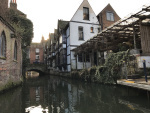
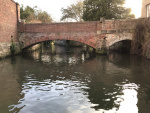
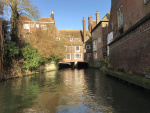
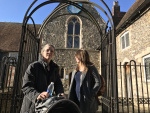


I am grateful for the chance to have gone to Canterbury having all the great work that the Time Team and many others have contributed so that my time as a born again college kid living on the campus of that ancient city could wander around the streets with my notebooks, books, and camera validating in the microcosm something that interests me greatly on the macro. The evidence was there for everyone to see and it was fixated on that spot because for the western world, it was the cradle of civilization. Literature by Geoffrey Chaucer first drew my eye to Canterbury and my daughter’s marriage to one of its sons was the second, but before these events Canterbury was already ancient and laced with a deep history that was covered by time and only unearthed by human ambition through war and profit. And that made eating pizza across from the Westgate Towers much more meaningful and mysterious as the echoes of the past came to me uniquely through the circumstances of authentic living for just a short time in an ancient place dying to tell its story on a global scale through whispers in the wind and ghosts from its catacombs.
Rich Hoffman
CLIFFHANGER RESEARCH & DEVELOPMENT
Sign up for Second Call Defense here: http://www.secondcalldefense.org/?affiliate=20707 Use my name to get added benefits.



March 4, 2017
The Virtue of Material Acquisition and Spending Money: Defying thousands of years of wrongly framed thinking
I am not suggesting that any person spend money like a bottomless pit buying anything everywhere to cover up some deep psychological problem. That is a different issue from what I’m proposing. Money is simply a representation of value so when someone spends money without considering the implication of cost they are essentially unable to grasp the concept of value because psychologically, they are lacking the basic foundations to do so. However, and this is a uniquely American way to think which was drawn incredibly clear for me while traveling recently through London, Paris, Brighton and many other places in between and observing the people there and comparing them to those I have known back home in the United States. Additionally, as one of my many occupations, I am an employer and am an expert in the breakdown of labor=productivity and the psychological implications of personality=quality+implied effort toward targeted outcomes, so what I’m about to say requires some advanced context—because it eludes most people living on the earth today—and my assertion of these concepts comes from very advanced knowledge earned the hard way, and in my view, the only way.
I had the fortune to grow up and know both of my grandparents very well. Both were farmers and had obviously had their world outlook shaped by the Great Depression. One was particularly keen about every penny spent and watched them like a hawk always afraid that some big wave would come and overtake them wiping them out forever into poverty. They were extremely hard-working people and were socially very honorable, but did reflect a constant fear that their money would be taken away by some unknown force be it a disaster or the aggressions of mankind through some form of robbery—so every penny was watched for their entire lives. The other set of grandparents were rather loose with their money. If they wanted something they bought it and never gave much of a concern if something cost thousands of dollars even back in the 60s, 70s and 80s. If they wanted it they’d do what they had to in order to obtain it—whether it be a farm, a particular car, or just a lifestyle.
While traveling around Europe there was this constant phantom in the back of every conversation I had with people I interacted with, from family, friends and mild acquaintances which were shocked that we did so much in such a short period of time while people who were regionally located had spent their whole lives 60 miles to 100 miles from the things we were doing as a family in Europe yet had never tried to do them themselves. And it came up more than once at dinner tables that my youngest grandson who was at this point only 10 months of age had already been to Disney World once, and was now traveling around Europe with my daughter and her husband. Additionally while he was still a fetus he traveled around Iceland the year before so before he was even a year old had experienced vast cultural influences which are the foundations of a very interesting coming life that he will have—but people hearing all this just didn’t understand. “You spent how much at that Ramsay restaurant in Chelsea?” “You took the Eurostar to Paris just to go to the Louvre?” “Why go all the way out to Stonehenge just to look at some old rocks?” Those were the kind of questions we received just over the last few weeks by people mystified by the amount activities we reported through small talk which of course opened up a deeper sore which rests on the surface of most things human beings do in their lives. What is the value of a human day and what does one wish to do with those days toward a value that is internally comprehended at the subconscious level?
That same daughter who traveled with me just recently purchased an iPhone 7 Plus after working with mine on that trip and I was proud of her because it’s the best on the market at this particular time and I like to see she does not compromise quality for the comfort of saving a few dollars. Just like my view that if we are in London and my wife wants to go to the best restaurant that they have—why not do it? Essentially if I really want something, I typically get it. I don’t feel that way about everything and I do go through a screening process. Such as Stonehenge is something that I’ve mulled around for years, but the expense wasn’t worth the trip just for that endeavor. But If I’m in London on business, or leisure, then I’ll find a way to get there—you better believe it. I am not the kind of person content to just watch from my front porch others doing things and not doing them myself. To me nothing on earth is off limits—if I want it, I’ll get it. With that in mind, when I hear someone say that this is too expensive, or that is too far out of reach, I lose respect for those people because what they are really saying is that they are not willing to do the extra work to acquire the things their heart’s desire and are more than willing to yield to complacency.
Such people who do the minimum in life favoring the lazy position of being victims of circumstance are miserable human beings. One thing that makes Donald Trump a uniquely American product is that he has the kind of mind that never felt limited by circumstances. He dreamed big, lived big, and was more than happy to show off how much harder he was willing to work than his contemporaries. Because after all what is a man really showing off when he arrives at an exclusive club in a Lamborghini with a hot woman on his arm looking very debonair? He’s not saying he just inherited millions of dollars from his dad, or that he’s willing to waste large volumes of money on nothing—he’s saying that he is willing to outwork his peers and has obtained success and by fluffing his feathers declares himself above those around him so that he can have top access to the best that mankind has to offer—whether it be women, productivity, or leisure opportunity. Those who point jealously at the man are those simply not willing to do what it takes to acquire such things. They resort to socialism hoping to be equal to the man without having to do the work so that they essentially don’t have to feel the guilt of underperforming in a world which rewards people like the Lamborghini driver over those who watch every penny fearful that the penny might be taken from them at some point forcing them to work one hour longer to make it up in the future. People who deliberately set low bars for themselves are constantly unhappy when they have to live in a world where people are free to work and gain all they can and this is the cause of much anxiety in the world. By having a guy like that Lamborghini driver in the White House the expectations for our national economy will naturally expand which I see no negative to at all. People who are afraid of hard work won’t like it because the social bars of expectation will be raised out of their range of desired applied effort—but that’s good for America as a whole for obvious reasons of economic expansion.
What I observed in Europe was something completely foreign to me. I knew about it, but actually spending significant time there the situation was glaringly obvious. They think small in Europe. They have too much vacation time-they sit and talk too much about nothing and are content to live with the limitations they inherited from their ancient ancestors and they have grown as a region to accept many restrictions which keep them from really living life. I personally don’t have any of those limits in my life because honestly no matter how much I spend, I’m willing to work harder than anybody else to have what I desire. I may not care to have a Lamborghini because I’m not interested in the social things that come with it. I’m married and not looking for women, and I usually do things with my family so there isn’t a back seat for them to sit in when we go out to dinner so the value isn’t worth the cost to me. But if I wanted one, I’d buy one and nothing would stop me from getting it. There really aren’t many “things” I want in life because material objects don’t bring much value to me—intellectual things do like books—but “things” themselves don’t do it for me. But when I want a particular gun, or a motorcycle, or an iPhone—or a television—I get the best of whatever it is and I don’t think about the cost because I am literally willing to work 24 hours a day 7 days a week to obtain whatever it is.
That leaves me with absolutely no sympathy for the person who holds onto their money because they either fear someone taking it from them through aggression, or that they just are afraid of hard work. The person who is afraid to take their wife out to a nice dinner isn’t being fiscally prudent as much as they are just being a wimp afraid of giving up their leisure time to make their spouse a little more happy and comfortable. To select the cheaper version of a car to save money is setting the bar lower for other things and such people are artificially restricting the quality of their life to preserve their internal laziness—in most cases. And that’s a generally accurate way to identify much of what is currently sickening the world in regard to human beings. They want things that they see other people have, but they are not willing to do what it takes to have those things. In many cases their religions have given them a free pass to be lazy by constantly castigating the wealthy by highlighting poverty as some kind of virtue. And that has been a cleverly shrouded element in our society which has garnered little to no attention from our everyday life.
I fortunately was able to live in Canterbury for a good part of February 2017 and in that ancient city there are still monks who make the conscious decision to live in poverty—to essentially quit yearning for material objects so that they can earn their way into heaven. Its one thing to read about such things, it’s quite another to meet them and see them in the streets of Canterbury which I did. My wife and I even went to their little island in the Stour River to get a sense of how and why they live the way they do. Additionally, there are quite a few homeless people in Canterbury who have obviously quit life yielding to the escape of alcoholism. The two groups of purposely poor demographic groups had decided to set the bar so low for themselves that they were victims of circumstance and simply yielded their life to other controlling elements. Compassion is not the word I would use to explain their circumstance upon meeting them and speaking directly to them about their manner of living. They have quit life and have tossed it back to what they think “God” is—and by my definition for things are wasting themselves. It’s not honorable to be poor or to sacrifice their life for some greater good when what they are really hiding is their sheer laziness to get up each day and battle toward personal goals set for the benefit of being alive. Such as, you can’t take that car, that house and that nice watch with you into the next world. But what you do take is the experience gained in obtaining those things because the effort expands your intellect which has resonance into the many dimensional planes of reality that your soul resides on. So in essence, the work utilized in reaching for material goods and services has a natural byproduct that resonates across the universe into your eternal elements—and those monks in Canterbury are missing the point by deciding to live in poverty so to obtain the grace of God. And regarding the homeless people, I’ve been at points in my life where compared to them, they were much wealthier than I was—but I never quite working. A person like me would never be on the street without a house or the means to get one and to me there is no excuse in living on the street begging for food or enough scraps to get a bottle of alcohol to indulge in drunkenness. They are people who lack the internal drive to fight through each day and make the best of it—let’s be honest.
So those are some things to think about in regard to money, value, virtue, and immortal spirit. When my daughter told me she had bought a new iPhone 7 after working with mine I would say she did more for her eternal spirit than those Canterbury monks have done in 30 years of living deliberately impoverished in dedication to God—because the value isn’t in the material item—it’s in the productive output to acquire it. The morality of a good economy does more for assisting the soul of its recipients than deliberate quitting of the world does by yielding to the old forces of intellectual control over those willing to submit themselves to every authority. Doing what the heart desires for the right reasons is a more moral decision than sacrificing it to circumstance. It is not honorable to say “I can’t do this because of that, or that I don’t have enough of that to do this.” It is honorable to say I want that so I’m going to do this to have it because the virtue comes in the act of acquiring the means to perform the task. For instance the virtue of spending over $1000 on a meal isn’t the food itself or the obvious consumable nature of it—it’s in acquiring the $1000 to spend and in sharing that experience with the people you care about for the memory of it—and the message to them that they are more valuable to you than just setting the bar too low for everyone and holding them prisoner to your low expectations for yourself. Monks hide that low bar behind dedication to God. The homeless behind their lack of internal resolve to fight through personal challenges–and the lazy hide behind circumstances—whether they are too short, not smart enough, too weak, too something to be that guy who shows up to dinner in the Lamborghini with the hot chick on their arm—so reserve themselves to sitting on their front porch watching the world pass them by and claim that they are being “fiscally prudent.” They are just being wimps. And that is the harsh reality that so many people need to face—because they aren’t fooling anyone.
Rich Hoffman
CLIFFHANGER RESEARCH & DEVELOPMENT
Sign up for Second Call Defense here: http://www.secondcalldefense.org/?affiliate=20707 Use my name to get added benefits.



Swamp Monsters Attack Trump Before the Election: Obama caught tapping the phones at Trump Tower
As if we didn’t know it already early in the morning of March 4th 2017 Donald Trump found out that President Obama just before the November 2016 election had Trump’s phones tapped in Trump Tower using the government to spy on a political rival—obviously breaking many laws in the process. As Democrats have attempted to do anything to put the new Trump administration on their heels to prevent proper management from the White House—the web of deceit gets more and more complicated making even the most far-reaching conspiracies light up with complete clarity. And Donald Trump did the correct thing; he went to Twitter before any of the news outlets were even up and broke the story as he found out about it.
Terrible! Just found out that Obama had my "wires tapped" in Trump Tower just before the victory. Nothing found. This is McCarthyism!
— Donald J. Trump (@realDonaldTrump) March 4, 2017
Imagine a sitting president using the resources of government to spy on private citizens to preserve their own dynasty of control? If you read what I say everyday here, of course you can imagine it. But now you have the confirmation dear reader of just how far these people were willing to go, and thank goodness we now have a president who is willing to set things right—starting with being very vocal in his criticism as he discovers these types of things.
Is it legal for a sitting President to be "wire tapping" a race for president prior to an election? Turned down by court earlier. A NEW LOW!
— Donald J. Trump (@realDonaldTrump) March 4, 2017
Just out: The same Russian Ambassador that met Jeff Sessions visited the Obama White House 22 times, and 4 times last year alone.
— Donald J. Trump (@realDonaldTrump) March 4, 2017
The reason for attacking Jeff Sessions is to keep the new DOJ from prosecuting all these crimes that did occur—and to consider that Trump was willing to extend the branch of friendship to his former political rivals and be a graceful winner. Well, not anymore. Time to go for the jugular, and I’m sure Jeff Sessions under Trump’s direction will have a field day with this very revealing information about just what kind of monsters live in the swamp of Washington D.C.
Rich Hoffman
CLIFFHANGER RESEARCH & DEVELOPMENT
Sign up for Second Call Defense here: http://www.secondcalldefense.org/?affiliate=20707 Use my name to get added benefits.



March 3, 2017
Even in Europe, People Love Trump: How using Saul Alinsky is making the Democrats extinct
No matter where I traveled in Europe during the month of February 2017, when people found out I was an American they wanted my opinion on Donald Trump. From the local pizza maker across from Westgate in Canterbury to the immigration officer in Paris—and literally everywhere in between, Donald Trump was on everyone’s mind. On literally every television in every café and pub was the image of Donald Trump’s ruckus romp through the global authenticating of American values, and people everywhere were fascinated by him. At Heathrow the rental car terminal driver had on a radio news station and all the talk was Donald Trump and as he saw my cowboy hat deduced that I was an American—and he was excited about how the new American president was sticking it to everyone. “Gotta’ love that the man does what he says he’ll do,” he said to me. “Do you like what he’s saying there in the States?” Of course, my answer to all of them was similar, I said that Trump was something new and special—he’s not a politician, he’s a business guy, and the rules have changed for all of us for the better. That was the most appropriate answer for these political novices in Europe who had simply never experienced someone like Donald Trump in their 2000 years of human history—and they were loving it. For them Trump represented that courageous push back that they dared not do in their own cultures and it is behind all that which has Democrats in the States so worried. Trump isn’t just being effective in America—his impact was resonating around the world in ways nobody had calculated—except for maybe me.
This whole business over the new Attorney General Jeff Sessions ties to Russia and other members of the Trump cabinet from Kellyanne Conway’s feet in the couch of the Oval Office furniture to Ivanka Trump’s clothing line has been an attempt to deflate the bombastic Donald Trump and wound this global influence before it’s too late. But I would argue that it’s way too late now. I stood outside a Paris café waiting on my family to complete some souvenir acquisition tasks and watched a group of men gathered around a flat screen television high up on the wall sipping beverages and pointing at an image of Trump smiling. It was some soccer match they would otherwise be watching, or a cricket highlight—or even rugby, but it was the American president Trump capturing the imagination of the world with an optimism that was unstoppable. The broadcast came on the heels of a release from NASA that Trump wanted to go to go back to the moon by 2020, and that Trump was trying to close the “gender gap” while advancing help toward African American communities—which are all things that seem very un-Republican. As Trump did these things the stock market Dow Jones index shot over 21,000 for the first time as over 3 trillion dollars of investment had flowed into the American economy in just two short months of the Trump presidency. Something was going on that was capturing the world and there was no way to stop that momentum now, and the Democrats seem to be sensing their own end—and the desperation was becoming more palatable in their actions.
Even more comical was the notion that the same old Saul Alinsky playbook would work with Trump—so by alienating the people attached to him—that the foundations of Trump could be destroyed bringing down the president and putting him into a political version of a prevent defense. But that won’t work with Trump because he’s his own man. If Jeff Sessions is taken out politically, Trump has a deep bench of people to replace him with and it won’t do anything to slow down the administration. The biggest problem that current Democrats have is they don’t understand the situation—they believe Trump is defined by the typical middle-class white man who Saul Alinsky broke down in his Rules for Radicals book way back in the 70s—which was constructed by studying the mob and the effectiveness of their lore upon public opinion. Yet Trump is an evolution beyond that kind of “man,” and even people in other cultures understand that. The typical “white” male from European decent has never in the history of civilization stepped out of the common mold of human by being created in the vacuum of church and state to produce such a uniquely independent thinker. So Saul Alinsky’s observations conducted through analysis of Al Capone’s mobsters won’t work because Trump has evolved beyond them. As a builder in New York with an unusual independence streak, shaped with a family that loved him, a successful father who helped him get a solid start in life, then being sent to a military school to fine tune Trump’s unusual demeanor—as a businessman he has had to deal with unions, mobsters and radical leftist progressives just to get his projects done. And he’s mastered those needs leaving him uniquely fashioned to sidestep the Saul Alinsky strategies applied to him by the present Democrats. Even if all of Trump’s cabinet people were eliminated, he would still be successful as a president and would be unstoppable, because what drives him is not any association with groups. Trump functions best independently and this is the real problem for Democrats who are not equipped for such a person in any of their strategies.
Europe looks at America with fascination anyways, the roads are huge as well as the cars. America makes the best movies and television and their food is limitless. The lifestyle standard of the typical American far eclipses those of the European who is used to small places to live without dish washers, air conditioning, or large voluminous showers with bountiful quantities of hot water. In Europe, they don’t tip so the service isn’t very good in restaurants and they still live under the looming control of their medieval churches even if they have turned to satanic cults and radical Islamic terrorism. The root cause of their misery is their long history of submitting to the controls of the politicians of the state and the various religions and their power-hungry clergy. People who came to America to get away from those kinds of controls eventually settled and became Republicans. Democrats were those who came to America to make it more like Europe so collective submission to hokey pokie medieval concepts was their baseline behavior—which is why everything is a cult to them—environmental issues, union membership, political submission—etc. So now they are dealing with a person who is not like them at all in Trump. Yet the current president is one of the first of his kind born in America by a system of capitalism that has freed him of the guilt of his European heritage and is truly acting as a product of freedom for the first time at such a level in the history of the world.
There was a lot for the Europeans to be curious about regarding Trump. His behavior mystifies them and they were quite energetic to speak to me about him—not in a bad way, but curious at how a man like Trump could function so independently of collective input. In America, at least half of us understand—and we typically call ourselves Republicans. But elsewhere in the world people just don’t stand up against orthodox systems like Trump dose. It just doesn’t happen. But now it is and the Europeans trapped behind 2000 years of obedience are seeing for the first time what human potential looks like, because for once, it’s not defined by collective associations, but rather the integrity of the individual, in this case Donald Trump. And what they are witnessing is more than history, entertainment, or even curiosity—it’s a philosophic transition from dependence to independence at the most fundamental level possible and the Democratic Party is going extinct because of it.
Rich Hoffman
CLIFFHANGER RESEARCH & DEVELOPMENT
Sign up for Second Call Defense here: http://www.secondcalldefense.org/?affiliate=20707 Use my name to get added benefits.



March 2, 2017
Robert Cushman in the Westgate Tower: Where America was born–and the reason for separation of church and state
[image error]For my wife and I it was a bit of an overwhelming moment, only because we both love history and have a strong reverence for the Holiday of Thanksgiving in the United States. I had known that Robert Cushman who originally commissioned the Mayflower for the famous voyage to North America which of course unleashed the famous Thanksgiving Holiday that we celebrate each year unlocking the Christmas Season, but I didn’t think I’d ever get close to sitting in the cell where he was held imprisoned by the Church for spreading protestant pamphlets. Yet, while touring the city streets of the ancient city of Canterbury, England at the Westgate Towers I found myself in a room exhibiting the shackles that were used for holding prisoners there and sure enough on the wall was the information talking about Cushman’s ordeal that led to the start of the Mayflower voyage in that very room.
Just toured Westgate Tower where Robert Cushman was imprisoned. Once released he commissioned the Mayflower in Canterbury for America. pic.twitter.com/aJP1eEtdmA
— Rich Hoffman (@overmanwarrior) February 28, 2017
[image error]A lot of people these days don’t really understand the necessity, and context of the argument between American separation of church and state because they have been free all their lives and have a shallow knowledge of history. But for Cushman who’s only ambition in life was to be a grocer on the streets of his childhood home in Kent he was a very passionate religious person who found himself in the crosshairs of the Church and their desire to be the primary vehicle through sacrament to Heaven. Cushman naturally resented that control and wanted a more passionate relationship with God directly. So the Church had him thrown in jail and as he sat in the cell at Westgate his young mind set him on a life course that would usher in the first pilgrims into the New World and start the concept of America.[image error]
In a lot of ways, the birth of the United States happened right in that spot in Westgate so it was a little overwhelming. The role that Canterbury played was phenomenal—it was a town that featured at least two major earthwork mounds that are credited to the pre-Roman period, but I personally think are even thousands of years older—likely the same type of people who inhabited the Stonehenge area over 100 miles to the west. Both St Augustine’s Abby and a gigantic mound the size of the Miamisburg Mound in Ohio sit among the ruins of the great Roman city that set Canterbury on its start. But then the Romans pulled out a few 400 years later and in came the Anglo Saxons from Germany and elsewhere. But William the Conqueror from the lineage of the Viking Rollo invaded from France and dominated the countryside. When he came to Canterbury the people surrendered without a fight and thus the great Cathedrals began, first at St Augustine’s Abby, then the great Canterbury Cathedral and the region quickly became known as the Church of all England. Fast forward another 500 years or so and Robert Cushman was wanting to apprentice as a grocer but as a young passionate man critical of the Church’s role in the issuing of the sacrament found himself locked away in that old Roman tower.[image error]
As many historians understand, the Church of England was always in a perilous relationship with the kings of England and some, especially Henry II and Henry VIII had especially contentious relationships with the power the Church held and pushed up against it. This often put the people of England in the crosshairs of politics whether they wanted to be or not just by their association with needing religion in their lives. The church and the state were always at war with each other leaving people like Martin Luther and eventually Robert Cushman to make extreme personal sacrifices to be free of the mess. As he sat cold in the Westgate Tower Robert Cushman made a decision that if and when he was released that he’d escape to someplace friendlier to his religious views. When he was released, he fled to Holland to live for 9 years but had to leave again because a treaty with Spain was due to expire in 1619 which meant the Spanish Inquisition would soon legislate that little country—so Cushman had to flee again back to his homeland to find some other means of escaping the tyranny of the church and its battles with the state. So he commissioned the Mayflower in Canterbury to take his small group of protestant followers to a New World where they’d be free to follow their passions which took them to the famous Plymouth Rock in Massachusetts.[image error]
When Satanists and radical Islamic lunatics want to claim that separation of church and state allows them to do whatever they want to whomever they like—they have an inaccurate view of the context of the statement. The separation of church and state was to prevent the situation that Robert Cushman and his pilgrim followers experienced on the ancient streets of Canterbury, England—where they couldn’t be thrown in the Westgate Tower just for having a different view of how the sacraments should be administered to the public. The Church in its insecure position with the kings of England felt that Rome should continue to stand at the gateway to Heaven, and not those heredity selected masses of human flesh called kings—and if they lost that authority for just a decade of their existence, then the kings would push against the church for power over the people—so the poor people of England were caught in that vice between the state and the church. People in America didn’t want to find themselves in that situation and they certainly didn’t want to be thrown in jail for having a different belief, as Cushman was.[image error]
For my wife and I it’s one thing to know these stories, it was quite another to stand in those spots and walk down the same corridors as Cushman did and to see what he did under similar conditions. If I had been Cushman, I would have been beyond pissed off and I don’t blame him a bit for organizing his pilgrimage to America to escape such nonsense. It’s also important for those of us in America to honor the spirit of that first journey. In many ways, this is the big debate surrounding the immigration debate to this day. Refugees around the world are fleeing broken regions for the hope that America can shield them with freedom of persecution and economic mobility. However, there are some who flee to America to destroy it from within from that same jealous Europe and all the fallen empires of the past for that first sinful act of defiance which Cushman fled from to begin with. They do so not with military might, but with that paradox of squeezing society between the church and the state once again—such as what the radical Islamic terrorists have been advocating in their terrorist’s attempts. The imposing religious beliefs of these modern terrorists are just a modern version of the medieval inquisitions being imposed on the here and now. Yet the argument between church and state is the same as it was in Cushman’s time, only now we’ve run out of places to run. So now we have to stay and fight because America is the last place on earth that is free of that type of tyranny. And that is why we really celebrate Thanksgiving, and why for my family, it’s a very special Holiday.[image error]
Rich Hoffman
CLIFFHANGER RESEARCH & DEVELOPMENT
Sign up for Second Call Defense here: http://www.secondcalldefense.org/?affiliate=20707 Use my name to get added benefits.



March 1, 2017
Old Sarum: Speaking to us from a time that earth forgot
[image error]Like Dover Castle, Old Sarum was fascinating because on top of previously built prehistoric mounds the Romans, the Normans, then several successions of English kings built magnificent castles providing many layers of study. While I was impressed with the amount of earth moved to make the mountain Dover Castle sits upon I was simply awestruck when I saw Old Sarum. To think that human beings well before any mechanical earth moving machines made these tremendous mounds is literally jaw dropping. In the case of Old Sarum, there is over 5000 years of history at the site which places it as part of the earthworks culture just 6 miles north at Stonehenge which I have previously written about. CLICK HERE to review. That made the location a must see for me. Additionally, just two more miles to the south from Old Sarum is the Salisbury Cathedral which holds one of the four original Magna Cartas under the spire which shoots up over 400 feet into the air declaring itself the highest point along the vast plain. Of course the American Constitution was based on the Magna Carta so there is a lot going on in this very small region of the world, and I would argue that the preservation of all this history is due to the primary event by William the Conqueror when at Old Sarum he forced the land owners of England to come and commit themselves to his rule which was a dominating act in itself, but one that protected the region around Old Sarum for the next thousand years and preserved all these wonderful historical monuments. Old Sarum was more than a fortress which would inspire thousands of fantasy films, Arthurian romances and provide the stereotypical backdrop for a medieval castle—it was literally a protector of a snapshot of human history saving the area much the way it would have appeared to William the Conqueror upon arriving for the first time.
Some spectacular views from Old Sarum pic.twitter.com/qFxsgLxkaO
— Rich Hoffman (@overmanwarrior) February 28, 2017
There is no way photographs can capture the sheer scale of Old Sarum. It’s one of those places that only a human eye can rationalize upon being there. When arriving from the north the fortress completely dominates the skyline and to fathom that it was being worked on at the same time as Stonehenge is something to behold. I’ve been to the Cahokia mound site outside of St. Louis and this Old Sarum is much larger. The ditches around the two-layered fortification are deep, and considering the amount of erosion that had occurred over the years, were still extremely steep. To think human beings carried away all the dirt to make this complex is just inconceivable. The castle and full cathedral which used to be on top of the earthworks are gone now, but just to think of the massive amount of human effort to build everything is astonishing. I always felt that what Old Sarum suffered from is that archaeologically, it gets tossed into the medieval study group, so the people who work the digs put an emphasis on that period of time, from around 1070 AD until the time that the new cathedral was moved from Old Sarum down into Salisbury in 1227 AD. The regional politics of the area were such that from the time that William the Conquer used the site to unite his kingdom and solidify his rule, to housing the Magna Carta in the new facilities, up to the present time, the entire region has been uniquely protected for modern study, which makes it extremely special around the world.
A view of the old cathedral at Old Sarum pic.twitter.com/ikHlLBNNcJ
— Rich Hoffman (@overmanwarrior) February 28, 2017
I would argue that it is because of the influence that the Romans had on the area, and the huge political effort excerpted by William the Conqueror then the personal care of Henry II all the way up the line that the 50-mile radius around Old Sarum has been spared from war, looting, and further religious defacements which protected sites like Stonehenge and Avebury to the far north. Farmers did move into the area, but other major cities never rose up around Old Sarum and no foreign attacker ever dared to come close to penetrating the English countryside from that angle of the island continent. I think the evidence is quite conclusive that these mound building cultures were all over the world—these exact types were certainly in North America—but Russia, China and many other places have their share of these earthen reflections. [image error]However, their borders have often changed many times over the centuries and hostile immigration often accompanied such movements and the thing to do was to deface the culture that was previously there. For instance, the ISIS terrorists in the Middle East recently have been plundering the museums around Iraq and Syria and destroying great archaeological sites to preserve their Quran history of the region—so not to have any contradictory influences in their spreading of their religion into new borders—the way such things have been done for thousands of years to a greatly destructive effect. The Quran text is a very new Muslim religion, written down for the first time in 632 AD so the cultures that built Stonehenge and Old Sarum are much older and would have been susceptible to a competing religion defacement if they had been located in a region of the world that was unstable. But because of the might of England’s long reins of power extending into the modern world Old Sarum has been spared the spoils of war and its ominous influence protected it until the establishment of an imperial global presence. This gives us the purest look in the world into our own history.[image error]
China has a number of unique earthworks, but study there is regulated to the communist government which censors everything. They are currently in the business of editing their own history so that their current communist regime won’t be challenged by their more than a billion residents. That kind of censorship has been going on in the United States for a long time as the political desire to show that the Indians were harmed during westward expansion has taken precedence of true archaeological study. In North America, the mound builders have been associated as groups of Indians—in an effort to designate them as the oppressed people harmed by Christopher Columbus’s journey across the Atlantic and to blame Europe for discovering the New World in 1492 AD. The problem for modern science is that the plot doesn’t fit the politics—obviously, the cultures that built Old Sarum, Stonehenge, and Avebury were able to bring gigantic 30 ton rocks down from Wales by sea and carry them up the shallow Avon River—but we are to believe that they weren’t sailing across the channel into France, Ireland, Greenland, and North America at a time many thousands of years before Christ was born. This is because Christianity dominated Medieval thought all the way up through the Renaissance and now all the political boundaries of the world have been established based on those histories and nobody wants to change them now with all this new evidence—because of politics.[image error]
Old Sarum and the archaeology of the entire Salisbury plain say otherwise and reluctantly established science is beginning to change their minds off the assumptions of their grant funding from previous quickly deduced discoveries such as the characteristic that the Druids were the builders of Stonehenge which came from the Anglo-Saxons out of German shortly after the Romans left and the Normans invaded England. The people who worked and lived in the area of Stonehenge and Old Sarum were much older, and more organized than anybody has given them credit for previously—and how they came to know what they do about astronomy is just mind bending—for a supposed “primitive” people. Those same people were in North America doing work like can be seen at Old Sarum and Stonehenge well before the Chinese began migrating into and settling the New World centuries before Columbus. In fact, the North American “Indian” it is proving out was just a Hodge podge of global cultures abandoned by the Vico cycle only to begin again as hut dwellers who could barely thatch together a roof—let alone build massive structures that aligned with the stars, the sun and the moon on particular days of the year and had monuments on the ground visible from space to appease gods who were only passed down through oral tradition.[image error]
Old Sarum was to thank for the preservation of a culture that would otherwise be destroyed in other regions of the world and it is due to its massive political influence over a great period of time landing it in the present. Without Old Sarum I would say that Stonehenge never would have survived into modern times—it would have been looted over and over again and likely would have had someone’s church or mosque built upon it to hide what had been there before. And so long as this is the way of the world, we can’t assume to know anything about our past or who did what when—because politics and religion have essentially erased most sites like Old Sarum from the maps of our understanding. Even giant mounds like the one at Old Sarum have been built over and destroyed due to human migration that didn’t know the large hill they built their house upon, or a city was an ancient dwelling of any kind. So it was quite a special to roll through the old English countryside to see the massive behemoth of Old Sarum perched high among the landscape defying convention. The place was fascinating to me not for the Medieval archaeology it presented, but for the window into the past that it preserved, and for that I am very grateful. What a fabulous site. I am very happy to have seen it, in many ways it was more spectacular than Stonehenge, but more importantly, because of it, Stonehenge can still speak to us from a time that earth forgot.[image error]
Rich Hoffman
CLIFFHANGER RESEARCH & DEVELOPMENT
Sign up for Second Call Defense here: http://www.secondcalldefense.org/?affiliate=20707 Use my name to get added benefits.



February 28, 2017
The Wonderful Work of English Heritage at Stonehenge: Looking 8000 years into the past at a truly global culture
I am a hundred percent sure that when Saint Brendan’s mythic stories were told about sailing across the Atlantic into Canada around 512 AD—1000 years before Christopher Columbus—that the trade routes into the New World were already many thousands of years old. Saint Brendan was only one of the more recent visitors and I was able to confirm this by visiting the fabled wonder of the world—Stonehenge. I’ve read and watched many documentaries about Stonehenge and the extremely mysterious earthworks all over the Salisbury Plain all the way up to Avebury including the famous Uffington White Horse and I’ve had my suspicions. I knew there were mounds similar to what are in my home town of Ohio which are generally attributed to the Adena and Hopewell Indians—but upon arriving at the vast and newly refurbished Stonehenge Heritage site, it was clear beyond a reasonable doubt that the same culture of people who built the earthworks at Stonehenge were the same who built them in Ohio and the surrounding area within the United States meaning that there was trade and communication between Europe and America many thousands of years before modern times. The evidence was extremely overwhelming. As I stood at Stonehenge and looked 360 degrees in every direction I could see mound earthworks which all looked like those found in Fort Ancient, in Ohio. And 20 miles north in Avebury was the Silbury Hill which was an even larger version of the Miamisburg Mound that I’ve spoken so much about. At Stonehenge the great novel, Finnegan’s Wake came to life before my eyes as science merged with myth to confirm a reality that was all too distressing for the human race.[image error]
Before continuing, let me report something very positive. As much as my visit to The Louvre in Paris was extremely disappointing, the visit to the new Heritage Vistor’s Center at Stonehenge was completely positive in every way. I continue to be extremely impressed with the Heritage people within the United Kingdom. My membership with them is something that I will always treasure. Everywhere I have gone from the Saint Augustine’s Abby, to Dover Castle, Old Sarum and several other sites, they always have a good staff on hand to promote the Heritage work and the featured site. Most notably was the Old Sarum location just about 6 or 7 miles South of Stonehenge—which I will talk about in another article extensively because it was actually my target for exploration—not Stonehenge, and was absolutely spectacular. That site was relatively remote yet the Heritage staff had a very nice acquaintance area with drinks, books, and even restrooms far better than The Louvre. It was something to step across a long bridge over a deep ravine to come out on the other side and have a cozy little shed with the Heritage staff inside to get you off the windswept plains surrounding the magnificent monument. But Stonehenge is kind of the capital monument for the Heritage team and the one that has received all the press over the years—so everyone knows it—and what those fine people did there was simply amazing.[image error]
The big improvement is that the road that used to run immediately through Stonehenge had been removed and replaced with an almost amusement park like setting with the visitor’s center over a mile away from the ancient ruins. In year’s past the viewing area for the megaliths were out near the concentric circle which has always surrounded the temple area. However, not anymore. Under the English Heritage leadership the viewing area now takes you right up next to the site without destroying the ground under foot. And by moving the visitor’s center way down the road they have separated the incoming tourist traffic with the sacredness of analysis at the actual site. I thought it was just brilliant because really for the first time you could stand in the middle of what used to be a modern public road and look out all around at the region and that’s where all the mounds surrounding Stonehenge were extremely obvious—more so than in any documentary that I’ve ever seen on the subject. There were hundreds of them, all like those at Fort Ancient, Ohio in size and technique. These two cultures knew of each other and practiced similar mythic rituals—and that was no prehistoric accident.[image error]
I photographed extensively, but all the earthworks around Stonehenge are just too massive to capture properly, only the human eye can put a scale to it properly. Much to my surprise archaeologists are now beginning to relax their apprehension to some of the extreme dates around Stonehenge—going back over 8000 years to some of the features—which is a whole new chapter on understanding human development particularly regarding the Stonehenge Cursus which is a very long runway type of earth feature that is over two miles long and 420 feet wide clearly meant to be seen from the sky at very high altitude. On the ground it is nearly invisible, but it is so large and vast, that only from very high up can it really be seen. It is every bit as mysterious as a Nazca line in Peru. It would have been quite majestic to the ancient world and was a sign that a very ancient people knew how to make very straight lines over many miles from the vantage point of the ground which is not easy to do. The way that the Heritage group was able to remove the road through the Stonehenge site allowed really for the first time a proper analysis of the entire area under modern scrutiny. It’s one thing to look at some big rocks on the side of the road back when nearby Amesbury was being built 50 years ago and put all the emphasis on the stones. But it is the surrounding mounds and earthworks that really tell the story—or begin to—which required someone to take the leadership to protect—which is what the English Heritage, the group, has been able to do over the last 10 years.


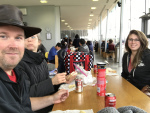
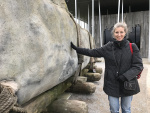
On the business side, Stonehenge was making a killing on a Sunday afternoon at the end of February. They had a fabulously large café with many people working the cash registers. The gift shop was enormous and filled with people. They had a great museum, not large, but effective. And they had great bathrooms for an entertainment destination in a remote part of England, out on the edge of the western plains an hour outside of London. It was cold outside and very wet, and breezy and the various commercial enterprises allowed for people to get out of the cold, which is actually a problem all through the year. The style of the visitors center itself reminded me of the Space Port in New Mexico—meant to look integrated with the surrounding hillsides and unobtrusive. From the parking lot my son-in-law thought the whole complex was a shack because it looked like a partially constructed giant barn of some kind with a very flat and waving roof. But that was on purpose to fuse modern and ancient styles together into a unique work of art which was highly functional—and smart. The complete opposite of The Louvre which is a place that had a lot more to work with, but lazily passed on the opportunity. The English Heritage folks had made the most out of almost nothing and what they brought to the exhibit of Stonehenge was something that would have been at home at Disney World’s Epcot Center. Making money helps preserve and uncover history and it is just so wonderful that at least in England they have the English Heritage people who are merging capitalism with historic preservation and unleashing the discoveries of the past at a record pace. Put money into science and guess what, you get productivity.
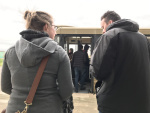



But the most important aspect of Stonehenge which is now undeniable is the story around it—the vast complex of ancient earthworks that obviously migrated into North American and likely many other sites around the world. With all the criticism of western conquests and imperialism which we hear so much about in politics, if not for those attributes of an advanced civilization imposing itself on inferior ones—we wouldn’t have things like Stonehenge, and the British Museum. If not for William the Conqueror making a mountaintop fortress out of Old Sarum to the south of Stonehenge, likely someone would have farmed up the ground and destroyed many of the earthworks which are still raw on the surface of the land. But under the civilized guidance of England’s national superiority which expanded into a massive empire of its own eventually, such treasures would not be protected from the Vico cycle of terror that often comes when civilization moves from democracy, anarchy then back to theology. It was England’s global superiority that has preserved Stonehenge for us all to see today. Likely there were similar sites in China, Russia, all over the Middle East, and in North and South America—but the chaos of politics and land grabs have prevented adequate archaeology—which continues at Stonehenge. That makes the English Heritage work to my mind one of the most important on planet earth because there at the site of Stonehenge is a glimpse into mankind’s real past which holds truths we are only beginning to admit to ourselves. Because the big mystery is not why such an ancient people went to the trouble to move such large rocks from over 200 miles away to arrange them in the fashion they did at Stonehenge—it’s how they came to know how and why to do such things. Additionally, who did they talk to and what was the real limit of their global influence? That to me is the big question and the bookmark in history to the mystery of how civilization continues to follow the Vico cycle ever and ever again into the abyss of recreation. And it is possible that the people of Stonehenge knew a lot of things that we have yet to learn, because they had already seen it many thousands of years before and like many people in search of the everlasting played their part in articulating the mysteries of the universe to put the brakes on human regional self-destruction through art revealed through great effort.
Rich Hoffman
CLIFFHANGER RESEARCH & DEVELOPMENT
Sign up for Second Call Defense here: http://www.secondcalldefense.org/?affiliate=20707 Use my name to get added benefits.



February 27, 2017
Donald Trump and Saint Augustine: Becoming a missionary of justice to fight off the pagan insurgents
It was intensely bizarre for me personally to be standing at the grave of St. Augustine in his demolished Abby while watching the media reaction to Donald Trump’s CPAC speech on my iPhone because in a lot of ways, what Trump and Steve Bannon are doing presently reflects accurately what St. Augustine did in 597 AD under the assignment of Pope Gregory. Rome had to withdraw its troops from Britain to protect its crumbling empire and Anglo Saxons had moved into south England bringing with them their pagan religions to corrupt the countryside away from Christianity, which had been brought to England by the Romans. Augustine set up a mission in Canterbury and formed a friendship with the pagan king Æthelberht of Kent and within a few years the Roman Catholic Church was converting pagans to Christianity serving as the first of its kind anywhere in the world. What happened in Canterbury would be done to the far corners of the world in favor of the Catholic Church following the manner for which Augustine had conducted the enterprise. Eventually during the reformation in England King Henry VIII would destroy the Abby and loot it of its wealth which left the place in ruins at Canterbury. But the body of St. Augustine remained for me to observe as I finished watching the speech fall out by Donald Trump who was given a similar task, this time not by a Pope, but by the people of the United States to spread the message of Americanism to a world hell-bent on anti-capitalist objectives.
They are carrying Trump's CPAC speech live in the U.K. @DanScavino @realDonaldTrump @KellyannePolls @seanhannity that's not America outside. pic.twitter.com/d0wTBMTAWf
— Rich Hoffman (@overmanwarrior) February 24, 2017
Trump’s message to the media during CPAC was firm, that they were no longer relevant and that the White House would not be moved off its objective of returning Americanism to the land of the free as opposed to the pagan chaos of the parasites that had moved in and taken refuge in the shadows of the weak leaders that have emerged over the last century due to a more global focus on philosophy and economics. Stunningly the whole speech was carried live in England from the start of it to the end and endless commentary spewed forth after. Donald Trump like St. Augustine before him was a vessel for undoing the damage caused by poor thinking and the lack of structure adhered to by an advanced culture. For instance, the moment the Romans moved out of England, the society reverted back to the tribalism of the Germanic people following perfectly the Vico cycle—where democracy turns to anarchy, then back to theology—and thus under St Augustine, then by the influence of the Nomads, the spreading of Christianity spread again and gave birth to a new age which lasted for over a thousand years.
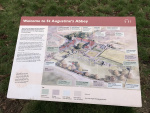

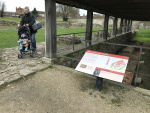
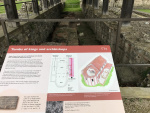
Trump is engaged in the same kind of effort. The emphasis of his presidency is one with a long goal in mind, to change the culture of America back toward patriotism and to vanquish those who speak against it, which has been the entire world. And the world cannot turn away because Trump is such a great topic to cover, they can’t help but put him on television. Even as Jodi Foster held a rally against Trump and the attendees of the Oscars were winding up for a celebration of the black, gay film Moonlight—Trump was planning his own celebrations which would divide up the media coverage of what is often a monopoly held by Hollywood on Oscar night. For the first time ever a sitting president wasn’t licking the heels of the Hollywood community, but was standing in defiance of them during Oscar night. Even as Hollywood and their Academy members bent over backwards to put a film like Moonlight into the limelight—to show they aren’t racist elites in Santa Monica, Trump was beating a different drum and the world was listening—a national patriotism that was intent to convert people back to what built the country.
[image error]Our politicians in America and the media culture that followed it were a lot like the Germanic people who invaded England once the Roman Empire withdrew. That is always what happens when a powerful force from a superior culture takes away its influence. The masses collapse on themselves and chaos ushers itself in. This was the subject of the great Ayn Rand novel Atlas Shrugged, where the producers of society withdrew their talents and society quickly crumbled away. What has been told to American culture was that we should embrace all these “Moonlight” values and establish our society on those foundations, which of course lead to a degradation of the human condition—as we see presently in Paris. Even as all this news was spewing forth about the Oscars and Trump’s CPAC speech across Europe, President Hollande was complaining about how disrespectful Trump had been toward the city of Paris—and the news cycle did almost nothing but talk about it.
In the past lesser people would feel the burden of not being accepted by the actors of Hollywood, or the press, or even global socialists like Hollande, but Trump doesn’t care, because he is on a mission and his drive is not created from other people, it is generated from within. And that’s what the world doesn’t understand. I could see it clearly watching the news while I toured the St. Augustine Abby and paid respect to the tomb of the Saint himself. Trump was that modern voice who had to step into a pagan land of lawless behemoths and establish order among them. Trump gets all his strength from within himself, in his faith in his ability. Augustine put his faith in God so he was able to step into a hostile environment and establish the first Church of England. Trump is doing something as we speak that will be talked about for thousands of years and that history is happening in the present—and it’s quite something to see.
It is during events like this which is why I love history so much, because understanding these types of things explain contemporary occurrences with context. Because once you understand the Vico cycle and the patterns of the human race, you can know the outcome of something that is happening which of course happened before. Only instead of the topic being Christianity as it was in Augustine’s time, it is now the concept of Americanism, which to my eyes the world desperately needs. The pagan losers in Hollywood like Jodi Foster, Casey Affleck and many others never understood the meaning of America, and are completely unable to define it. And the kids in the media, all those entertainment writers and beat reporters who are under 30 years old and have a lifetime of lessons to learn before really being able to inform a public of a viewpoint beyond the facts of a matter—they are lost and rootless and will quickly convert to the Americanism that Trump and Steve Bannon are proposing. Just as the skeptical Æthelberht listened to Augustine for his first years of missionary action then converted to Christianity from his pagan roots—the world too will do the same with Trump. And Trump knows it.
The real fear that isn’t being said at the Oscars, in France, in the media and in the CNN newsrooms, the New York Times boardroom, and all the others who are finding themselves on the outside of Trump’s White House. They are aware of it too, that they are about to be extinct. Trump is converting pagans to Americanism and his White House has more global influence than all of Hollywood and the modern press put together and it is driving them crazy to realize how irrelevant they are. And that was the purpose of the old cathedrals, they were to impress upon the residents the power and majestic triumph of the Catholic Church which strengthened their faith into God and the Church’s role in statehood. Trump is now doing that with the White House, using that majestic platform to spread the benefits of Americanism. And the pagans know they are losing their grip on the American public because Trump doesn’t need anything from them leaving them completely powerless. And that is a great thing!
Rich Hoffman
CLIFFHANGER RESEARCH & DEVELOPMENT
Sign up for Second Call Defense here: http://www.secondcalldefense.org/?affiliate=20707 Use my name to get added benefits.



February 26, 2017
Socialism is Destroying The Louvre: Capitalism is the best way to preserve art and history
For a museum that opened in 1793 and had been used as a personal residence of King Francis I and many others after him serving around 10 million visitors a year and is one of the most celebrated of its kind in the world, I had high expectations for The Louvre in Paris. I love museums, I absolutely adore the one in Cincinnati which I visit several times a year called The Museum Center. However, I have always assumed that places like The Louvre were far superior—after all, when one thinks of Paris they think of two things, the Eiffel Tower and The Louvre so my pilgrimage to that historic museum was something I had thought about for decades. Perhaps it was because I had been spoiled by the various Heritage sites across the English Channel in England. My wife and I are members of English Heritage which gives us free access to important historic sites all over England from Stonehenge to Dover Castle and everything in between. Even relatively small sites like St. Augustine’s Abbey in Canterbury have wonderful museums that go along with their preservation sites. I had spent a week leading up to my visit to The Louvre visiting Heritage sites and spending a lot of time at the British Museum in London—and I have to say, I was in heaven. They were so wonderfully organized and put together and the literature they offered was immense and provided me with years of reading.


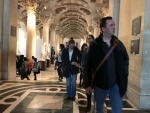

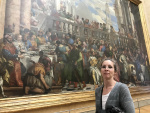

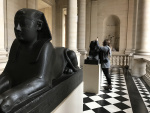

Yet when I arrived at The Louvre I was greeted with chaos and socialist mayhem. Let me begin by saying that if The Louvre had been in the United States, it would be the greatest attraction in the world, including Disney World. The building itself was immaculate, stunning even. And the museum collection acquired under Napoleon rivaled anything else in the world. It was remarkable. The combination of contemporary design with the ancient was everything I hoped it would be. But the main problem with The Louvre was that it is being operated by socialists who have no idea what they are doing. They have this wonderful museum with all these people coming to it—but they literally have screwed up every aspect of the enterprise starting at the front gate.
My family arrived surprised to see an hour-long line outside the pyramid. We naturally assumed that this was the line to purchase tickets. So we stood in the cold needing to use the restroom for just a little over an hour only to find out that the line we were in was just for security. The Louvre had enough visitors on a Wednesday afternoon at lunch time to populate a football stadium in the United States, yet the security forced everyone to go through two lines of airport like security which took forever. Everyone understands that The Louvre is a target for terrorist attacks, but they should have at least had 7 to 8 security lines to properly handle all the museum visitors. By the time we all got through security we all had to use the restroom—badly. One of the worst things in France is that they don’t know how to give people places to use the restroom. They have these ridiculous public restrooms on the sidewalks that hardly work. Every time I tried to use one it malfunctioned and the seat would come up and the door would come up to the outside letting everyone in the world see you. So we didn’t use those. I thought we were in luck by the major tourist attraction of Notre Dame. We followed the signs to the “toilets” only to go down a series of steps to find a group of east Europeans sitting in a group behind a steel cage charging 1 Euro to go through turnstile just to use the restroom. So guess what, we turned around and decided to wait until we got to The Louvre thinking it would be like the Museum Center in Cincinnati—and would have like rows of places to use the restroom. By the time we arrived in that hour long line, we had to go badly and it was almost unbearable by the time we got through security. There certainly wasn’t any place to go in the courtyard around the pyramid. Now that we were through security we rushed to the restrooms before buying tickets and found a line there too—especially for the women.
I told my family that I’d step into the men’s room, use the restroom, then I’d get our tickets. By the time I got through that line I thought the girls would have a chance to get through that massive women’s line. Now keep in mind that this was a Wednesday afternoon in February. It wasn’t Saturday in the middle of the summer. For a museum of this size, there was no way there should be lines like what we saw at The Louvre. Going into the restroom it was pandemonium, and there were as many women in there as men. It was sheer chaos. And there were only four urinals. I managed to use one and did as I said and went to stand in another line to get admission tickets. After standing in lines for over two hours we had our tickets and were ready to see the museum. My wife and daughter gave up on the women’s restroom not moving at all for over twenty minutes and used the men’s room under the guidance of my son-in-law. That solved one problem, now we had another one, we needed to eat.
The plan was always to eat at The Louvre so we didn’t stop at any of the many little restaurants on our way. We figured we grab a bite to eat, spend about 10 minutes eating it, then we’d get into the museum and get to work. But no, they had only like three restaurants and all of them had half hour lines. My wife and I managed to get some food as my daughter and her husband waited for an additional 15 minutes to get the same type of food. The food itself was pretty good, but the means to get it was horrendous. The employees were slow and unmotivated. They didn’t care how big the crowds were, they weren’t getting into any kind of hurry. Service in France is just unfathomably terrible. Nobody cares about anything and everyone just exists. And at The Louvre, customer service was not a priority.
Once we got through all that we enjoyed the museum, but the way the experience started put a bad taste in our mouth. If The Louvre had been in America there would have been about 10 restaurants all around the grand room and plenty of seating and bathrooms. Getting tickets for a museum, using the restroom and obtaining food should be easy things for such a large tourist attraction so that visitors could spend their time learning and doing things. But under the socialist country of France, they even managed to screw up a slam dunk of a great tourist attraction, and turn it into sheer misery.
The whole thing told the story of why socialism is so terrible and how capitalism services society so much better. Even in England they get it, the Heritage people understand how they make their money to offer services to a public which funds the preservation of art and history. But The Louvre, they are missing millions of dollars of opportunities and are just living off their reputation—which won’t last forever. They need approximately ten times the bathroom capacity and that much equally in restaurant availability. They certainly have the room for it, but obviously not the business sense. If I were running The Louvre I’d seek out a partnership with McDonald’s—someone who knows how to serve massive amounts of customers quickly. I’d also bring in other American fast-food chains who are just as good—obviously, the French don’t know how to do that on their own and I’d set them all up on some of those blank walls in the main area under the pyramid outside of the ticketing area.
It isn’t cool to provide bad service, and it certainly doesn’t place people above the bourgeoisie of society to drag ass everything. Bad service is just disrespectful and it says to visitors of The Louvre that the management doesn’t give a rat’s ass if anyone visits or not. And from what I saw, The Louvre really doesn’t care if anyone comes. They think they are entitled to the business and they think that because there really isn’t much else to do in Paris except visit museums that they’ll get by with this kind of thing for the foreseeable future. But I’m sure I’m not the only visitor to The Louvre to come away feeling disenchanted by their terrible service. They have a lot of lessons to learn, and for their own sake, they better start learning them.
Rich Hoffman
CLIFFHANGER RESEARCH & DEVELOPMENT
Sign up for Second Call Defense here: http://www.secondcalldefense.org/?affiliate=20707 Use my name to get added benefits.



February 25, 2017
Paris is a Disaster: Stepping beyond progressivism and the metaphor of Sainte Chapelle
I’ve listened to people rattle on about how wonderful Paris is, the “great city of lights” for years now, and I really thought I was missing something. Not allowing for a lack of being there to shape my opinions I felt I needed to give the place a chance to win me over even though I knew going in that France was a socialist country and that I’d likely be disappointed. My family is of the type that we can make something good out of anything, so a little video of our trip can be seen below as we hit the major tourist sites, Notre Dame, Sainte Chapelle, the Louvre, the bridge of locks, and the Eiffel Tower and everything in between as we walked the entire length from the Eurostar train station all the way down to the tower. We didn’t do the tourist thing of riding in a taxi or a bus to get through the “quaint” neighborhoods with all their “great” personality to arrive at our destinations. We came to know the city through hard work—and boy did we get to see it up close. We did hire a bicycle cart to take us from the Eiffel Tower back up to Notre Dame because my wife had developed a massive blister on her foot and we wanted to get her back up to the Boulevard de Strasbourg for the heaviest part of the walk so not to risk being late for our train at the Gare du Nord. Given that little explanation, this is what our trip looked like getting to and leaving Paris.
But let me say this—Paris is a disaster. A city living off its past that has been destroyed by the chaos of kingdoms, religion, and now open border socialism. What I saw along just the Boulevard de Strasbourg was enough to convince me to shut down the city and start over, because they have a mess. It was more of a third world country than one of the premier capitals of the world—and their undisciplined immigration and loose lifestyles have eradicated the city of any nobility of character. The first sign of trouble came just a block from the train station where two men were arguing, one of them looked homeless. He had a large concrete block over his head threatening to throw it through a window while the other man cussed at him in French with great passion to put it down. We had to walk between them to get down the sidewalk and apparently, this goes on all the time because the other people with us on the crowded sidewalk were just going about their business. If that guy were doing something like that in the United States, somebody would have shot him, it’s that simple. The whole ordeal was just a hot mess representation of what a country with open borders and progressive socialism produces—anger, frustration, extreme poverty and dirty filth everywhere. But they do have diversity. There were immigrants from as far away as Sri Lanka to mass gatherings of Muslim Central Africans and associated cultures. Only an idiot would think that so many people without common beliefs packed on top of each other and prostitutes thrown into the mix was a good idea and evidence of a successful country. Prior to coming I had only heard about how wonderful the walk down the Boulevard de Strasbourg was. Well, those people must have been smoking crack, because it was among the worst that I’ve seen in any slum area in the United States—a defeated community failing by the day. And if it was that bad in the tourist area just think how terrible it would be just a few blocks in on both sides where the tourists don’t go. My thoughts were to give those people guns, let them fight it out and whoever wins, they would decide the nature of the community because as it is now, pickpockets, prostitutes and con artists are defining the nature of the city and that’s not a good thing.
After about six blocks of this things did improve as we came closer to the river Seine and armed police stood around everywhere with assault weapons ready to gun down any terrorist insurgents. Just two weeks’ prior an Islamic terrorist had assaulted people at the Lourve, which is one of the biggest tourist areas of Paris, so they weren’t taking any chances along the river which is the breadbasket of tourism for Paris. As long as we were near the river, I could see a glimpse of the Paris that people have been talking about. But it was like visiting a relative in the hospital whom you know is about to die. They are there talking to you and you reflect on their life while they are still speaking. But you can see the specter of death over their shoulders beckoning them to come hither. Paris was already dead, but the body of tourism just hadn’t yet cooled to show the menace to the drunken westerners looking to fill their illusions of the famous Moulin Rouge and the Hugo epic Les Misérables. It was a depressing situation far from the kind of optimism I’m used to in America.
As I said, we did get to visit our key sites and I couldn’t help but ponder the layers of mistakes. As beautiful as the old cathedrals like Notre Dame were, everything I could see was just piled up forms of socialism with the churches of the Middle Ages being the first to usher in the kind of collectivism that set Paris up for failure over a thousand years ago, I have read more about this stuff than most people would care to do in a lifetime and I was explaining a bit of it to my kids when were at the Sainte Chapelle because that is a perfect example of what’s wrong with Paris. In the lower chamber of Sainte Chapelle is a mini cathedral which represents our time on earth. On both sides of this room are tight spiral staircases which take you up and into the grand room above with large vaulted ceilings and stained glass enclosures 25 feet high. The spiral staircase represents death—or the birth canal into re-birth into heaven and this was the point of emphasis for the entire Middle Ages for which Paris was founded and the historic foundation visitors relish to this very day. I was happy to see it but I felt sad for all the suckers over the last thousand years who came to Sainte Chapelle after throwing their piss and shit out their windows into the streets below to worship in this truly magnificent place when the Greek and Romans had lived better 1000 and 2000 years earlier—and to think that what they were doing was cutting edge wonder—is just stupid. Paris was a city built on the back of the Vico cycle reverting back to the beginning to make the same mistakes all over again which were showing up just a short time later in 2017 where the culture had broken down to this scribbled mess of ancient religions which no longer spoke to the world due to their failure to update themselves to modern science.
Naturally a society so collectively based, and willing to throw away the here and now for the promise of everlasting life shown in the great cathedrals socialism became their new standard and that has led to the present despicable situation. On the way into Gare du Nord by train my wife and I marveled at the beautiful French countryside, but not in the way you might think. It looked much the way it had for many centuries, and hadn’t changed much. There were a lot of empty fields and very little industry. Then suddenly we were in Paris and then the frustrations of poverty were clear with all the defacing graffiti and long looks on the faces of the residents who have been poor all their lives and like the mythology of the Sainte Chapelle have retreated to religion to show them a light at the end of the tunnel. France had chosen poverty for its people and used environmental worship as just the latest religion to control the thoughts of their people into keeping their lives easily confined to the lower room metaphorically of the Sainte Chapelle where the average European has been for over 2000 years.
If France had adopted capitalism that countryside would have shown signs of more factories, nicer homes, and more commercial options like would be found in the United States—like an occasional Crackler Barrel for god’s sake. France and its socialist residents might come to the United States and balk at our unrepentant splendor of capitalism, of our big houses, cars and lifestyles where every few miles across the country are just about anything you could want and eat. And just like their past in Paris in forcing people into the Catholic religion and the cathedrals there to provide a state sponsored view of the everlasting, they haven’t improved. Sure they have a separation of church and state now, but not really. Instead of their religion being a Catholic one inherited from the Roman Empire that conquered them just a few years after the crucifixion of Christ they now have a progressive view of the world where any religion from any place can come and interact freely and without State regulations—which essentially allows every ethnic community to impose their version of Sainte Chapelle on everyone else. That terrorist who was shot recently at the Louvre threatening tourists with a knife is the same loser who for millennia before was beheading people for not following the rules of the cathedrals and adhering to the state sponsorship of the everlasting. Now the new religion is environmentalism and it is purposely keeping people poor so that they must look to the “State” for guidance which has created the deplorable situation along the Boulevard de Strasbourg. Sure women are “free” to walk around topless and earn as much money as a man. The men have been subverted into little shrimps of human flesh walking around in their cosmopolitan “skinny jeans” which obviously have shoved their genitals back up into them squeezing off their masculinity. And this has left nobody to challenge the failures of their vast socialism and the carcass of Paris which is cooling by the minute as rigor mortis is fast setting in.
Anyone who thinks Paris is a stunning city of “lights” is stuck in the distant past remembering the life that might have been from the vantage point of ignorance. It’s like remembering that abusive parent while they are on their death bed and the one time they bought you a nice snack somewhere, then beat you to a pulp because you used all their money in the act. Paris has committed suicide many years ago and has slowly been bleeding out all this time leaving us with a fine example of what not to do. Like all cities of socialism, it was a dirty place filled with crime leaving people desperate to make any money at all begging for it at every opportunity. Graffiti and crime are only the most obvious signs, but sex workers are the next layer. When people start selling sex in exchange for opportunity, that’s when you know you have a failing society and need to pass on some of those open green fields and build a few factories. Paris never had it right, not when they were conquered by the Romans, or settled by the Celts, or spent years at war with Spain and England pawning off their daughters for the promise of peace with a rival kingdom. Paris has always been a city of suppression even as women celebrate their nudity and their unshaved armpits as Madonna did for Playboy in the eighties to sell America on this garbage—like a big sister trying to get their innocent sibling to smoke cigarettes for the first time. The socialism of France was sold to us all through rebellion, with sex, violence, and red flagged upheavals—and their net result has been garbage and decay.
I was so glad to get out of Paris that the Coke I had on the way out on the fast train back to England never tasted better. The city lights faded quickly because there was nothing going on in the French countryside past 9 PM, nothing productive. Nobody was up late working third shift to make bowls for a thriving export, nobody was inventing the newest revelation of science and technology—the French people were just sleeping and paying respect to their latest religion hoping to climb those circular stairs upon their deaths to arrive in the grand room of heaven. And I was happy to speed right on by for the English Channel. As we went under the water and came up on the other side, and the time changed I felt relief to have been out of that dreadful place. England has its problems with socialism too, but at least they are intellectually curious people rooted in the capitalism of language. It was like that feeling you have after a funeral where the sad stuff is out of the way and you could get back to what you would normally do—you can take off the stuffy suit and put on some shorts and relax with your thoughts. Paris was a disaster and it will take anyone who follows it with it into the oblivion of death—which is the primary driver behind Brexit. Thank goodness, we are waking up in America because Paris was not an example anybody should follow, and I can say that now with firsthand experience.
Rich Hoffman
CLIFFHANGER RESEARCH & DEVELOPMENT
Sign up for Second Call Defense here: http://www.secondcalldefense.org/?affiliate=20707 Use my name to get added benefits.






